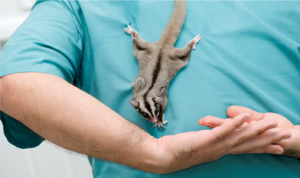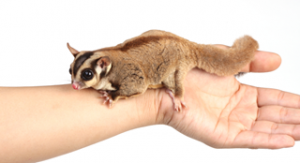 Q: I have a female sugar glider I bought 2 days ago. When I play with her in the afternoon she seems to be nice. But in the evening or at night when I wanted to take her out and bond with her, she acted differently, screaming and its fierce. She is very aggressive. She makes me feel like she wants to attack/bite and that scares me off from taking her out. In the middle of night, she keeps making loud noise but there’s nothing bothering/touching her. I am afraid to play with her. Why does she behave so aggressive? What can i do to solve this problem?
Q: I have a female sugar glider I bought 2 days ago. When I play with her in the afternoon she seems to be nice. But in the evening or at night when I wanted to take her out and bond with her, she acted differently, screaming and its fierce. She is very aggressive. She makes me feel like she wants to attack/bite and that scares me off from taking her out. In the middle of night, she keeps making loud noise but there’s nothing bothering/touching her. I am afraid to play with her. Why does she behave so aggressive? What can i do to solve this problem?
A: Gliders need a few days to get used to their new environment, so you just need to give her a little time to get comfortable in her new home. She also doesn’t know you yet, so to her, you are just a giant scary predator.
She is probably calmer and easier to handle during the day because she is sleepy. The screaming sound you are describing is probably “crabbing” and it means your glider is scared. It’s just a sound she is making to tell you to back off, and she is trying to protect herself. It does not necessarily mean she is aggressive.
The loud noise she makes at night is called barking, and this is normal. Some gliders will bark at night, and as a glider owner, it is something you have to get used to. This may let up once she gets more comfortable in her new home, but it may continue. It is a sound gliders use to call to other gliders, so it is just normal communication.
There are some things you can do to help her get used to you and learn that you are her friend. You can start by sitting near her cage and talking to her in a calm, soothing voice so she can get used to the sound of your voice. Offer her some small treats through the cage so she associates positive things with your presence.
You can also drape a piece of your clothing that you have just worn over the cage so she can get used to your scent. Gliders recognize members of their colony by scent, so if you smell unfamiliar to her, she will be scared of you. You can also wear a small piece of fleece and then put it into her pouch so she can use it as a blankie and it will also help her get used to your scent.
If she starts crabbing at you, just stay calm and don’t run away. You need to show her that you are her friend, and if you let her scare you, you will reinforce her behavior. She will sense your fear, so you have to stay calm and be patient with her.
Once she starts getting more comfortable with you and her new environment, you should start wearing her in a pouch close to your heart during the daytime. This will really help the bonding process. You can put a pouch in her cage and when she falls asleep in the morning in the pouch, you can take it out and put it around your neck and tuck it into your shirt. If she crabs, you can pet her gently through the pouch and talk to her in a soothing voice until she calms down. Offer her some treats in the pouch as well so she knows you are a friend.
You should also offer a treat when you let her out at night to play. You can also try licky treats, honey or yogurt on your finger, but be careful because they can bite when the food is all licked off.
The most important thing you can do is just be patient. Gliders will take their time bonding with you, so you will have to go at her pace. Once she bonds with you, it will be a lot easier to handle her.
 Q: I have a 9 month old male, got him at 6 months, he had never bonded with anyone. He gets up at about 8 pm and goes to bed at about 7 am. I keep him in my shirt pocket all day. When I get him out of my pocket he wants to go right back in, like he is shy. How do I get him to play?
Q: I have a 9 month old male, got him at 6 months, he had never bonded with anyone. He gets up at about 8 pm and goes to bed at about 7 am. I keep him in my shirt pocket all day. When I get him out of my pocket he wants to go right back in, like he is shy. How do I get him to play? Q: A friend of mine just gave me her sugar glider because she no longer had time for it. Now that I have him in my home, I am kind of scared to pick him up out of his cage because I’m afraid he will get away from me. What is the best way/time to pick them up out of their cages? I don’t want him to suffer from depression from not having enough bonding time, but I also don’t want to lose him. Is there anything you can suggest for my problem?
Q: A friend of mine just gave me her sugar glider because she no longer had time for it. Now that I have him in my home, I am kind of scared to pick him up out of his cage because I’m afraid he will get away from me. What is the best way/time to pick them up out of their cages? I don’t want him to suffer from depression from not having enough bonding time, but I also don’t want to lose him. Is there anything you can suggest for my problem? Q: I am considering adopting an adult glider. A friend has one and wishes to give it to me. Will it be more difficult for it to bond than a baby. What other problems might I consider?
Q: I am considering adopting an adult glider. A friend has one and wishes to give it to me. Will it be more difficult for it to bond than a baby. What other problems might I consider? Sugar glider bonding is important whether you have a baby or an adult. Bonding with adults might be more difficult than bonding with a baby, but it is not impossible. I bonded with my sugar glider when she was about 10 months old. I am limited to discussing my experience and therefore cannot comment on bonding with a baby younger than 10 months. I also cannot comment on having multiple gliders as pets.
Sugar glider bonding is important whether you have a baby or an adult. Bonding with adults might be more difficult than bonding with a baby, but it is not impossible. I bonded with my sugar glider when she was about 10 months old. I am limited to discussing my experience and therefore cannot comment on bonding with a baby younger than 10 months. I also cannot comment on having multiple gliders as pets.
Recent Comments